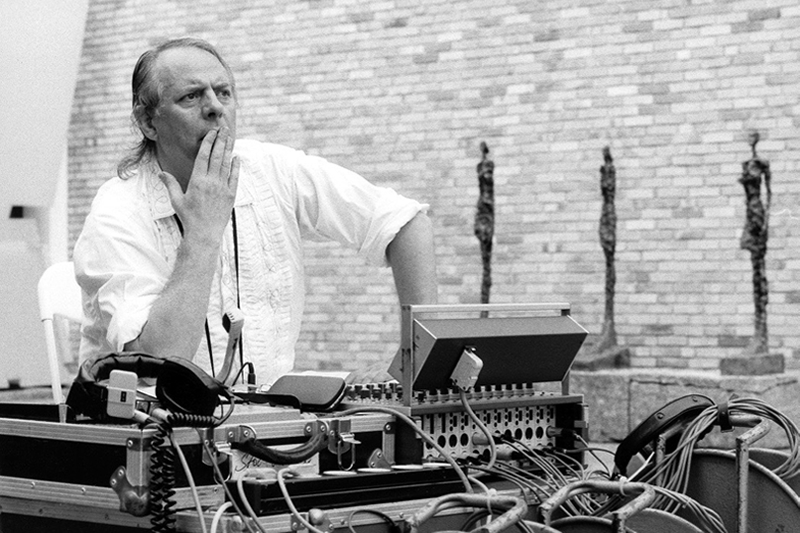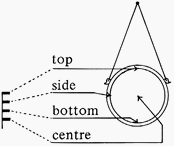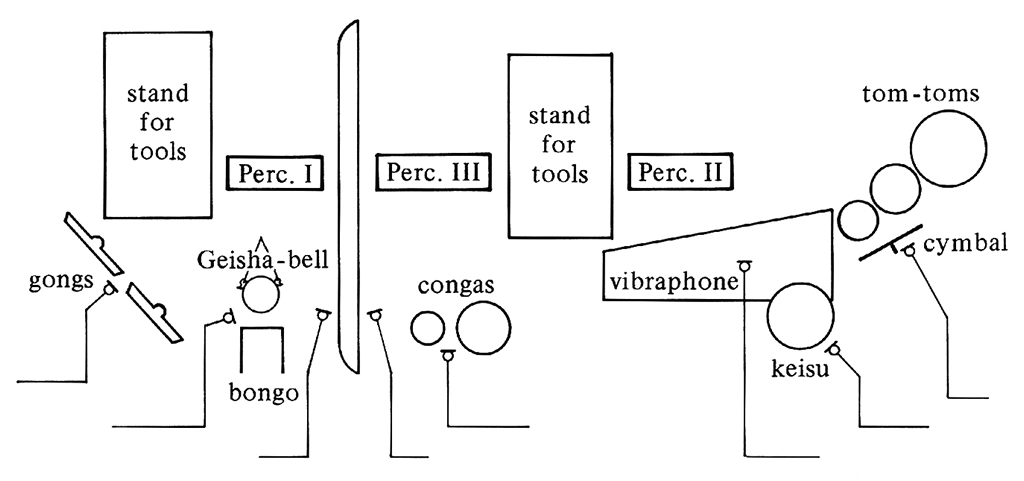
Instrumentation Works for Orchestra
Stockhausen Complete Edition on CD
Since 1991, a complete edition of all recordings in which Karlheinz Stockhausen has personally participated is being released on compact discs. Each CD in this series is identified by Stockhausen's signature followed by an encircled number. The numbers indicate the general historical order of the works.
Stockhausen realised the electronic music and participated in these recordings as conductor, performer, sound projectionist, and musical director. He personally mixed down the recordings, mastered them for CDs, wrote the texts and drew the covers.
- The compact discs may be obtained from the Stockhausen-Verlag: Kettenberg 15, 51515 Kuerten, Germany (www.stockhausenCDs.com).
Karlheinz Stockhausen
Instrumentation Works for Orchestra
MICHAEL'S JOURNEY ROUND THE EARTH
Performance practice for MICHAEL'S JOURNEY ROUND THE EARTH
Instrumentation1)
(all instruments are electrically amplified: see sound equipment)
| Solo trumpet in B-flat needs 6 mutes: Harmon, wawa, whisper, cup, plunger, melo-wah mutes (see mute photos and Notation). |
play from memory and act |
|
| Solo basset-horn | ||
| 2 | clarinets (2nd also basset-horn) | |
| 2 | alto flutes (both also flute) | |
| 2 | oboes (both also English horn) | |
| 1 | bass clarinet | |
| 1 | bassoon | |
| 1 | contra-bassoon | |
| 2 | horns Both need a mute. |
|
| 2 | trumpets in B-flat Each needs 5 mutes: Harmon, wawa, plunger, whisper, cup mutes (see Notation). |
|
| 2 | trombones (with F-attachment) Each needs 4 mutes: plunger, wawa, straight, Harmon mutes; 2nd trombone: cup mute in addition (see Notation). |
|
| 1 | bass tuba (in a scenic performance, playing from memory and acting in bars 279-346) |
|
| 3 | violins | The strings play with a normal vibrato except where a special vibrato is notated. |
| 2 | violas | |
| 2 | violoncellos | |
| 1 | double-bass (preferably playing bars 417-444 from memory) |
| 1 | harp (2 felt guitar plectrums for bars 242—279, hard plectrum for bars 321 -325) |
| 1 | harmonium (or synthesizer) (see Explanations 1) |
| 1 | grand piano (ad lib. with ring-modulator) (see Explanations 2) |
| 1 | electric organ (or synthesizer) (see Explanations 3) |
| 3 | percussionists |
| Percussion I: | 1 | large tam-tam ( = 155 cm) with special stand.
Percussion I plays the front side of the tam-tam (at the left, seen from the hall) = 155 cm) with special stand.
Percussion I plays the front side of the tam-tam (at the left, seen from the hall)(see Explanations 4). |
| 2 | Thai gongs  ( nipple gongs, bossed gongs )  thick solid beater (soft sound) thick solid beater (soft sound) back of spoon on the nipple (boss) back of spoon on the nipple (boss) |
|
| 1 | Geisha-bell with 2 original horn beaters  (see Explanations 5)
(see Explanations 5) |
|
| 1 | bongo, sound like Kakko (Gagaku orchestra) the same 2 beaters as for the Geisha—bell |
|
| Percussion II: | 1 | vibraphone vibraphone mallet and soft felt mallet |
| 1 | keisu (kettle bell) e.g.  (Japanese temple instrument, also called Dobaći or Ching-Tsching) with original beater |
|
| 1 | cymbal, bright (  ca. 45 cm ) ca. 45 cm )with sticks |
|
| 3 | tom-toms  |
|
| Percussion III: | same tam-tam as percussion I Percussionist III plays the back of the tam-tam (at the right, as seen from hall) (see Explanations 4). |
|
2 congas  with hands |
| 1) | A Soloists' Version of MICHAEL'S JOURNEY for trumpeter, 9 co-players and sound projectionist was made in 1984. lt may only be performed concertante. Instrumentation: solo trumpet, lst basset-horn, lst clarinet, 2nd clarinet (with 2nd basset-horn and bass clarinet), trombone (with tenor tuba or euphonium), alto flute, 2 percnssionists, synthesizer, electric organ (or 2nd synthesizer). |
Explanations about the instruments
| 1) | Harmonium: 2 manuals, pedal keyboard for bass notes; 16 foot register (adding a lower octave to the pitches of the bass system). Vibrato, molto vibrato, vibrato ritardando (with knee swell) which may be switched on and off for held sounds. Half-tone glissando, if possible (see bar 117). Registers which are similar to VIOLA, TRUMPET, OBOE plus 4 additional timbres (see bar 353 etc.) are needed. These must allow gradual timbre transitions (see bar 530 etc.). Where pitches have no designated registration, the conductor and harmonium player choose the timbre according to the sound context. Since good harmoniums are quite rare, it is possible to imitate the harmonium timbres with a synthesizer, or to record and play back the timbres using a sampler. |
| 2) | Piano (grand piano without lid): The harmonium player also plays the piano (bars 173-255). If there is ample rehearsal time, it is possible to ring-modulate the piano using a ring-modulator and sine wave generator (as in MANTRA). The sine wave frequencies which are to be set are notated above the piano system: bar 173 1st   , 2nd , 2nd  etc. etc.The modulated piano sound is then played back over a monitor loudspeaker next to the piano and, together with the unmodulated piano sound, over the loudspeakers in the hall via the mixing console (see Mixing console). |
| 3) | Electric organ: MICHAEL'S JOURNEY ROUND THE EARTH was written in 1978, when mobile synthesizers did not yet exist. Until 1986 various models of electric organs were used for the performances. Since 1986, Simon Stockhausen has played the organ part on a Yamaha DX7 II Synthesizer and a Roland D50 Synthesizer. Some of the timbres he has used were programmed, in rehearsals with the composer, for the Soloists' Version of MICHAEL'S JOURNEY. An electric organ with 2 manuals and with pedal keyboard for the bass tones is needed. 16' (16 foot) + 32' ( 32 foot) Registers are notated (switching on 1 or 2 lower octave parallels). Pitches like  require notes as low as require notes as low as . .Such pitches are only possible on very few electric organs (e. g. the large model of the Hammond organ). If these lowest notes are not possible, then the 32 foot register will have to be omitted. 8' + 2' means, that with 2' , octave parallels 2 octaves higher are switched on. Vibrato is a combination of amplitude modulation and slight frequency modulation (ca. 1/8 tone). It should be possible to turn it on and off for sustained sounds. 14 degrees of vibrato from  (slowest) to (slowest) to  (fastest) (fastest)as well as vibrato ritardando and vibrato accelerando are prescribed. Registers should sound similar to: VIOLA, FLUTE, BASSET, GUITAR, TRUMPET (in 4 timbres: Open , With harmon mute, with wawa mute, with cup mute), CELLO, VIOLIN, TROMBONE, ENGLISH HORN, BASSOON, ALTO FLUTE.  = continuous timbre transition. = continuous timbre transition. |
| 4) | The large tam-tam is played from both sides by percussionist I (the front of the tam-tam) and percussionist III (the back). It is the same tam-tam for which the works MOMENTE, MIKROPHONIE I, etc. were composed (Paiste tam-tam,  155 cm, with special stand: see also score 155 cm, with special stand: see also scoreMIKROPHONIE I, Universal Edition, Vienna). The Paiste company later changed the manufacture of this kind of tam-tam, using a much thicker material. These thicker tam-tams do not react nearly as well to the different ways of playing described below. One of the older, thinner tam-tams should therefore be obtained if at all possible. The method of playing is similar to that of MIKROPHONIE I. For all noises made by stroking, pulling and scratching with cardboard or plastic objects, the tam-tam must be rubbed on both sides with chalk and possibly, on certain spots, with rosin. |
 = very thick soft felt beater with hard centre. = very thick soft felt beater with hard centre. |
|
| Percussionist I needs the following for the tam-tam: | |
| 1 | plastic box without lid for SQUEAKING. The box, its edge held at an angle to the tam-tam surface, is drawn with great pressure in small jerks across the tam-tam. |
| 1 | cardboard tube which, when its edge is drawn across the tam-tam surface, produces the pitch  . . |
| 1 | cardboard tube or cardboard bucket for the pitch  . . |
| 1 | cardboard tube for the pitch , i. e. a tube which produces either this G or , i. e. a tube which produces either this G or  : , unpredictably. : , unpredictably. |
| 1 | metal spoon (ladle), the cup of which is struck (or touched lightly) against the centre of the tam-tam (caution: it easily becomes too loud).; |
| Percussionist III plays the same tam-tam with the following tools: | |
| 1 | lid of a cardboard box (e. g. l2 x 12 cm) for GROWLING.
(e. g. l2 x 12 cm) for GROWLING.The edge of the lid, held at an angle to the tam-tam surface – which must be rubbed with chalk – is lightly jerked across the tam-tam. The noise should be a low growling, like  (continuous rolled uvular R with  colouring). colouring). |
| 1 | cardboard tube or cardboard bucket for the pitch  (bar 20 etc.). |
| 1 | large cardboard bucket (bar 298 ff.) the edge of which is pulled across the tam-tam surface (very low drone or trombone tone). |
| 1 | cardboard tube or cardboard bucket for the pitch (starting at bar 681) (take over from percussionist I). |
| 1 | cardboard tube for the pitch (starting at bar 389). (starting at bar 389).(Sometimes an A instead of an E may come.) |
| 1 | long iron chain (bar 279 etc.), which is held hanging down in one hand close to the tam-tam and briefly held against the tam-tam so that a clanking rattling results, set in vibration by the soft beats of percussionist I (from the other side) (see further methods of playing bar 284 etc.). |
| 5) | The Geisha-bell is hung with its back to the player and is struck on the inside, against the rim or against the centre. These positions are notated on 4 lines. There is a large difference in pitch between strokes on the rim and at the centre; strokes on the rim, at the bottom, side or top, are varied in timbre but vary little  in pitch. Tremoli are played by loosely striking the upper and lower rim alternat- ingly with one beater, or with 2 beaters. The Geisha-bell used by the composer has the pitches  |
Percussion set - up
